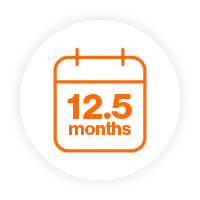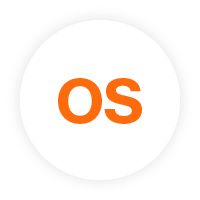

Help your eligible HR+/HER2– aBC patients achieve their treatment goals1–9
Indications:1
KISQALI® (ribociclib) is indicated for the treatment of women with HR+/HER2– locally advanced or metastatic breast cancer in combination with an AI or fulvestrant as initial endocrine-based therapy, or in women who have received prior endocrine therapy (ET)
In pre/perimenopausal women, the ET should be combined with a LHRH agonist
KISQALI is not recommended to be used in combination with tamoxifen.
KISQALI Summary of Product Characteristics (SmPC) can be found here.

First-line KISQALI + AI increased mOS by >1 year (12.5 months) vs placebo + AI in postmenopausal patients3
mOS at a median follow-up of 6.6 years was 63.9 months with KISQALI + AI (n=334) vs 51.4 months with AI alone (n=334) (HR=0.76; 95% CI:0.63–0.93, p=0.008)3
Protocol-specified final analysis of OS was a key secondary endpoint in the MONALEESA 2 trial3
The primary endpoint of investigator-assessed progression-free survival (PFS) was significantly longer in the KISQALI + AI group (n=334) vs placebo + AI group (n=334) (HR=0.56; 95% CI: 0.43 to 0.72; p=3.29×10−6 for superiority)10

KISQALI + ET* preserved QoL (EoRTC or TTD) across all three Phase III trials vs placebo + ET†6–9
Patient-reported outcomes for health-related QoL were secondary endpoints6–9
MONALEESA-2: KISQALI + AI maintained QoL (mTTD ≥10%) for 27.7 months vs 27.6 months with placebo + AI (HR=0.94 95% CI: 0.72–1.24)‡7
MONALEESA-3: KISQALI + fulvestrant maintained QoL (mTTD ≥10%) for 35.9 months vs 33.1 months with placebo + fulvestrant alone (HR=0.81; 95% CI: 0.62–1.06)‡8
MONALEESA-7: KISQALI + ET + LHRH maintained QoL (mTTD ≥10%) for 35.8 months vs 23.3 months with placebo + ET+ LHRH (HR=0.67; 95% CI: 0.52–0.86)‡9

In HR+/HER2– aBC, KISQALI + ET* is the only CDK4/6i with significant 1L OS benefit across three Phase III trials vs placebo + ET3–5
MONALEESA-2: At a median follow-up of 6.6 years, mOS was 63.9 months with KISQALI + AI (n=334) vs 51.4 months with placebo + AI (n=334) (HR for death=0.76; 95% CI: 0.63–0.93; two-sided p=0.008)‡3
MONALEESA-3: KISQALI + fulvestrant (n=484) showed a significant OS benefit over placebo + fulvestrant (n=242). The estimated OS at 42-month follow-up was 57.8% (95% CI: 52.0 to 63.2) in the KISQALI group and 45.9% (95% CI, 36.9 to 54.5) in the placebo group, (HR=0.72; 95% CI:0.57–0.92; p=0.00455)‡11
MONALEESA-7: The estimated OS at 42-month follow-up was 70.2% (95% CI: 63.5 to 76.0) in the KISQALI + ET group (n=335) and 46.0% (95% CI: 32.0 to 58.9) in the placebo + ET group (n= 337) (HR for death=0.71; 95% CI: 0.54–0.95; p=0.00973 by log-rank test)‡12
ESMO-MCBS and KISQALI
SAFETY PROFILE
A generally manageable and well-characterised safety profile with KISQALI + ET*1,13,14
Please also consult the KISQALI SmPC for the full safety and tolerability profile before prescribing.
*ET is defined as AI or fulvestrant, and LHRH.3–5
†QoL was assessed using the EORTC QLQ-C30 questionnaire: a validated tool used worldwide to assess QoL in patients with cancer. Time to definitive deterioration 10% (TTD; defined as ≥10% worsening of the scale score relative to baseline, with no later improvement above this threshold observed during the treatment period, or death due to any cause) in the global health status/QoL score was investigated.6–9
‡MONALEESA-2 primary endpoint: The primary endpoint of PFS significantly longer with KISQALI + AI vs placebo + AI (25.3 months vs 16.0 months, respectively; HR for disease progression or death = 0.57; 95% CI:0.46 to 0.70; p<0.001).10 MONALEESA-3 primary endpoint: The primary endpoint of PFS was significantly improved with KISQALI + fulvestrant vs placebo + fulvestrant: (20.5 months vs 12.8 months, respectively; HR= 0.593; 95% CI: 0.480 to 0.732; p< 0.001).15 MONALEESA-7 primary endpoint: The primary endpoint of PFS per investigator’s assessment was 23.8 months (95% CI: 19.2–not reached) in the KISQALI group compared with 13.0 months (11.0–16.4) in the placebo group (HR: 0.55, 95% CI: 0.44–0.69; p<0.0001).16
aBC, advanced breast cancer; AI, aromatase inhibitor; ARR, absolute risk reduction; CDK4/6i, cyclin-dependent kinase 4/6 inhibitor; CI, confidence interval; eBC, early breast cancer; EORTC-QLQ C30, European Organisation for Research and Treatment of Cancer core quality of life questionnaire; ESMO-MCBS, European Society for Medical Oncology magnitude of clinical benefit scale; ET, endocrine therapy; HER2–, human epidermal growth receptor 2-negative; HR, hazard ratio; HR+, hormone receptor-positive; LHRH, luteinising hormone-releasing hormone; mOS, median overall survival; mTTD, median time to deterioration; NSAI, non-steroidal aromatase inhibitor; QoL, quality of life; OS, overall survival; TTD, time to deterioration.
References
KISQALI® (ribociclib) Summary of Product Characteristics.
Mertz S, et al. The Breast 2022;65:84–90.
Hortobagyi GN et al. N Engl J Med 2022;386:942–950.
Neven P, et al. Breast Cancer Res 2023;25:103.
Lu YS, et al. Clin Cancer Res 2022;28(5):851–859.
Verma S, et al. Br Cancer Res Treat 2018;170:535–545.
Beck JT, et al. Cancer Res 2019;79:P6-18-14.
Fasching PA, et al. Breast 2020;54:148–154.
Harbeck N, et al. Ther adv Med Oncol 2020;12:1–8.
Hortobagyi GN, et al. N Engl J Med 2016;375:1738–1748.
Slamon DJ, et al. N Engl J Med 2020;382(6):514–524.
Im SA, et al. N Engl J Med 2019;381(4):307–316.
Borstnar S, et al. Radiol Oncol 2022;65(2):238–247.
Jackisch C, et al. Poster Presentation P4-01-01. San Antonio Breast Cancer Symposium 2022, 6–10 December, San Antonio, USA.
Slamon DJ, et al. J Clin Oncol 2018;36(24):2465–2472.
Tripathy D, et al. Lancet Oncol 2018;19(7):904–915.
UK | July 2025 | FA-11464288
Adverse events should be reported. Reporting forms and information can be found at www.mhra.gov.uk/yellowcard. Adverse events should also be reported to Novartis online through the pharmacovigilance intake (PVI) tool at www.novartis.com/report, or alternatively email [email protected] or call 01276 698370.

